Photographs: Truth Leem/Reuters Abhineet Kumar in Mumbai
When Mahindra & Mahindra (M&M) sold a controlling stake in its automotive component business, Systech, to Spain's CIE Automotive last month, investors celebrated the deal by pushing the company's stock price up by 4.5 per cent to Rs 989.4.
Anand Mahindra, the Harvard-educated chairman of the $16.2-billion Mahindra group, said the deal was a result of his effort to create value for shareholders.
But the deal also reflected a change in the mindset of Mahindra who was ready to let go of his control on the business.
When asked about this, Mahindra ducked the question, saying: "I would not get into the psychoanalysis."
Earlier in November, during an investors' conference call organised by global brokerage firm Nomura, Mahindra hinted at selling loss-making new ventures if customers did not accept M&M's products.
Investors have been concerned about M&M's diversification into non-core businesses.
…
Why investors love Mahindra & Mahindra
Image: A worker cleans a logo of Mahindra & Mahindra.Photographs: Babu Babu/Reuters
According to its latest annual report, for 2011-12, the company, which is India's largest tractor and utility vehicle-maker, has 114 subsidiaries of which 45 are loss-making.
Though Systech is eight years old, the sell-off came as a relief to investors. Systech, comprising listed subsidiaries Mahindra Forgings, Mahindra Composites and Mahindra Ugine Steel Company (MUSCO), and unlisted, Mahindra Hinoday Castings and Mahindra Gears, had a turnover of Rs 4,025 crore (Rs 40.25 billion) in 2012-13.
Of this, Mahindra Forging reported a net loss of Rs 114 crore in 2012-13 on a revenue of Rs 2,096 crore.
Mahindra Composites too reported a net loss of Rs 0.98 crore (Rs 980 million) during the year on a revenue of Rs 50.3 crore (Rs 500 million). And MUSCO reported a net profit of Rs 7.17 crore (Rs 71.7 million) on a revenue of Rs 1,441.9 crore (Rs 14.42 million) during the year.
The investors' exuberance came from the company's willingness to let go of the loss-making unit and embrace a global collaboration.
M&M has agreed to merge the five listed and unlisted subsidiaries under Systech and sell a controlling stake in the combined entity to CIE Automotive for Rs 770 crore (Rs 7.7 billion).
…
Why investors love Mahindra & Mahindra
Photographs: Paulo Whitaker/Reuters
The combined entity will then be merged with the forgings business of CIE. The new entity that will emerge will be called Mahindra CIE.
After the deal, which involves an open offer, CIE Automotive will own 46 to 52 per cent stake in Mahindra CIE, while M&M will hold about 20 per cent. M&M plans to use the proceeds from the deal to buy 13.5 per cent in CIE for Rs 740 crore (Rs 7.4 billlion); hence, the deal is cash neutral.
In 2012-13, M&M reported a net profit of Rs 4,099 crore (Rs 40.99 billion) on the net sale of Rs 67,354 crore (Rs 673.54 billion).
However, financial details of its unlisted subsidiaries for 2012-13 are not known yet because the annual report for the year is yet to be published.
For 2011-12, the company reported net profit of Rs 3,127 crore (Rs 31.27 billion) on net sales of Rs 59,417 crore (Rs 594.17 billion).
The biggest dent, of Rs 717.4 crore (Rs 7.17 bilion), in the year came from the Korean subsidiary, SsangYong Motor, in which the company acquired 70 per cent stake for Rs 2,100 crore (Rs 21 billion) in 2010.
The Korean utility vehicle maker had gone through a rough patch, running out of cash to pay salaries.
…
Why investors love Mahindra & Mahindra
Image: Mahindra truck.Photographs: Courtesy, M&M
Now, M&M has ensured an operational turnaround for the company by achieving the sales target of 120,000 units for the last year. A financial turnaround is expected to follow.
But the investors' real concern has been the truck and two-wheeler business. Last year, the truck joint venture, Mahindra Navistar Automotives, reported a net loss of Rs 310 crore (Rs 3.1 billion), while Mahindra Navistar Engines reported a loss of Rs 65 crore (Rs 650 million).
In December, the US-based joint venture partner in the two companies decided to exit following trouble in its domestic market. M&M bought Navistar's stake in the two companies for about Rs 175 crore (Rs 1.75 billion).
M&M had formed the truck joint venture in 2005, while the engine joint venture followed in 2007.
The joint venture kicked off in 2010, starting with the production of 25-tonne trucks from its new plant in Chakan (Pune) and later expanded to the medium and heavy commercial vehicle segments to produce 16- and 40-tonne trucks.
But the company has been able to get only about 2 per cent of the market share in the segments where its products are available.
…
Why investors love Mahindra & Mahindra
Image: Mahindra Centuro.Photographs: Courtesy, M&M
The commercial vehicle industry, which is dominated by Tata Motors and Ashok Leyland, has been going through a rough phase following the economic slowdown.
The picture for M&M's two-wheeler business hasn't been any brighter. Five years ago, the company acquired 80 per cent stake for Rs 110 crore (Rs 1.1 billion) in a company that was created by transferring the assets of Kinetic Motor Company.
Mahindra Two- wheelers, the subsidiary, reported a loss of Rs 238 crore (Rs 2.38 billion) in 2011-12.
Its first motorcycle, the Stallio, which was launched in 2010, failed in the market due to engineering glitches. Following this, the company restructured its entire business.
M&M is infusing fresh funds of over Rs 500 crore (Rs 5 billion) into its two-wheeler business. The company has already set up new assembly lines for scooters and motorcycles at its Pithampur plant with a capacity of 1 million units.
It is also re-launching the Stallio and has decided to launch one product every quarter for the next two-and-half years.
…
Why investors love Mahindra & Mahindra
Image: Employees walks past an assembly line of "Maxximo", a light commercial vehicle, at a new plant of Mahindra and Mahindra in Chakan.Photographs: Arko Datta/Reuters
"We believe that one of the key concerns for investors has been the losses in some new ventures like Mahindra Navistar and Mahindra Two-wheelers," Kapil Singh, an analyst at Nomura, had said in a report.
"Given the assurance from Mahindra, we believe M&M will not continue to invest in these businesses beyond a reasonable time frame."
M&M's diversification story has been in contrast with that of Pune-based Bajaj Auto which has been focused on its two-wheeler and three-wheeler businesses. The company, in fact, wrapped up its scooter business to focus on the premium bike segment.
Bajaj Auto reported a net profit of Rs 3,132.6 crore (Rs 31.32 billion) in 2012-13 on the net sales of Rs 19,533 crore (Rs 195.33 billion). What this means is that M&M has to sell over 3.4 times more to make a profit of nearly 1.3 times that of Bajaj Auto.
…
Why investors love Mahindra & Mahindra
Image: Anand G. Mahindra.Photographs: Arko Datta/Reuters
This is also reflected in return on capital for both the businesses, which is a key matrix to judge a company's ability to provide return on shareholders' money.
Bajaj Auto's return on capital for 2012-13 is 38.8 per cent, while M&M's is 20.54 per cent.
Bajaj Auto's market capitalisation has crossed that of M&M many times in the last couple of years.
Asked about this, Hemant Luthra, president of Mahindra Systech says: "You compare us with Bajaj Auto; I do not know what the answer is. All I know is that in 12 years, M&M's market cap has gone up 60 times."
M&M's market cap on Tuesday was Rs 60,350 crore (Rs 603.5 billion), while that of Bajaj Auto was Rs 55,501 crore (Rs 555.01 billion).

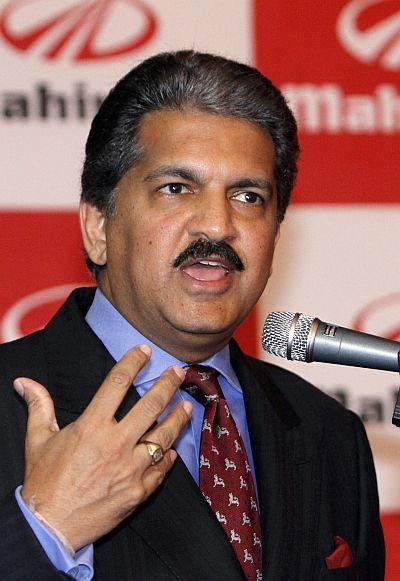
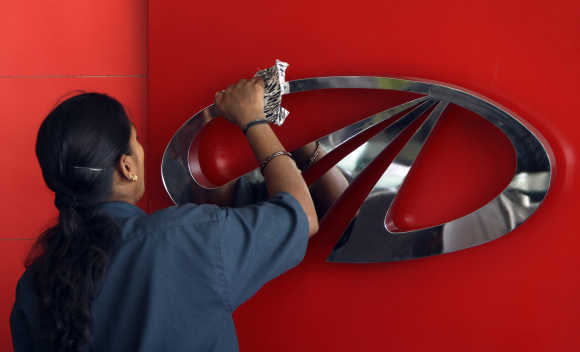

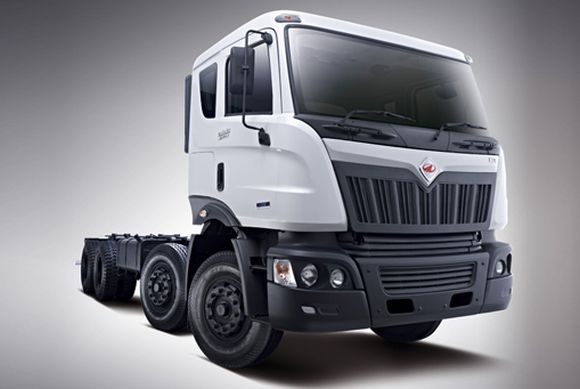
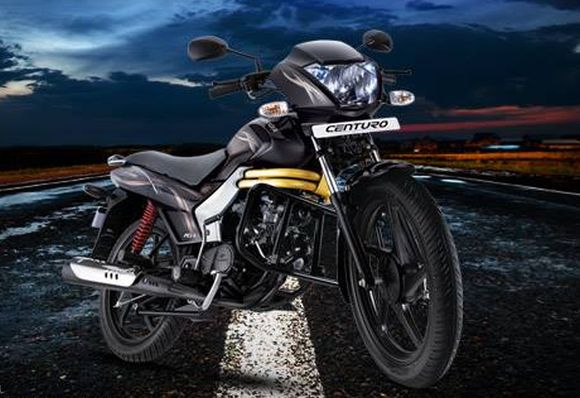
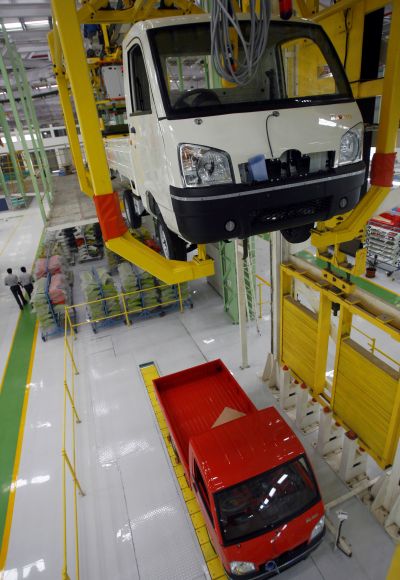
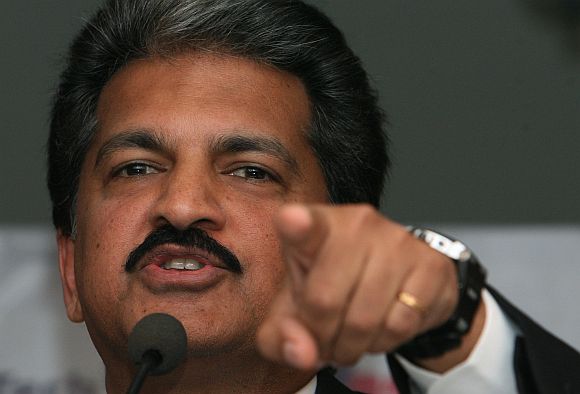

article